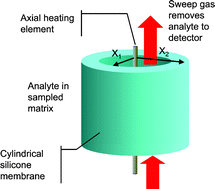The concept of achieving low-resolution separations in internally heated capillary membranes is discussed in terms of controlling the diffusion coefficients of volatile organic compounds in poly(dimethylsilicone) membranes in space and time. The behaviour of 1,1,1-trichloroethane in polydimethylsilicone was used in conjunction with a mixed-physics finite element model, incorporating second order partial differential equations, to describe time and spatial variations of mass-flux, membrane temperature and diffusion coefficients. The model, coded with Femlab, predicted highly non-linear diffusion coefficient profiles resulting from temperature programming a 500 μm thick membrane, with an increase in the diffusion coefficient of approximately 30% in the last 30% of the membrane thickness. Simulations of sampling hypothetical analytes, with disparate temperature dependent diffusion coefficient relationships, predicted distinct thermal desorption profiles with selectivities that reflected the extent of diffusion through the membrane. The predicted desorption profiles of these analytes also indicated that low resolution separations were possible. An internally heated poly(dimethylsilicone) capillary membrane was constructed from a 10 cm long, 1.5 mm od capillary with 0.5 mm thick walls. Thirteen aqueous standards of volatile organic compounds of environmental significance were studied, and low-resolution separations were indicated, with temperature programming of the membrane enabling desorption profiles to be differentiated. Further, analytically useful relationships in the μg cm−3 concentration range were demonstrated with correlation coefficients >0.96 observed for linear regressions of desorption profile intensities to analyte concentrations.

You have access to this article
 Please wait while we load your content...
Something went wrong. Try again?
Please wait while we load your content...
Something went wrong. Try again?


 Please wait while we load your content...
Please wait while we load your content...